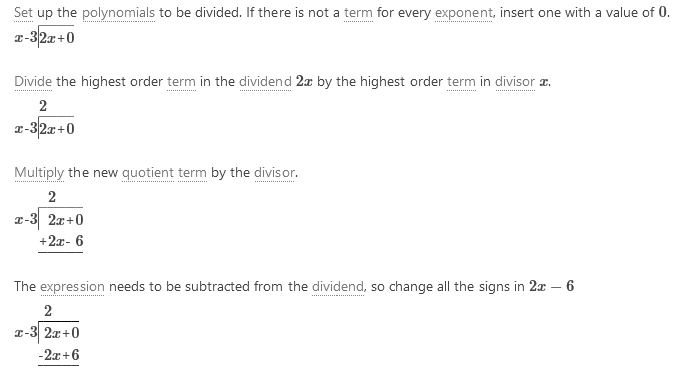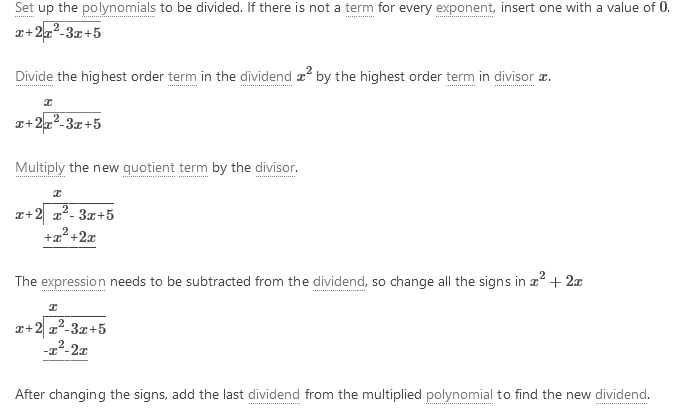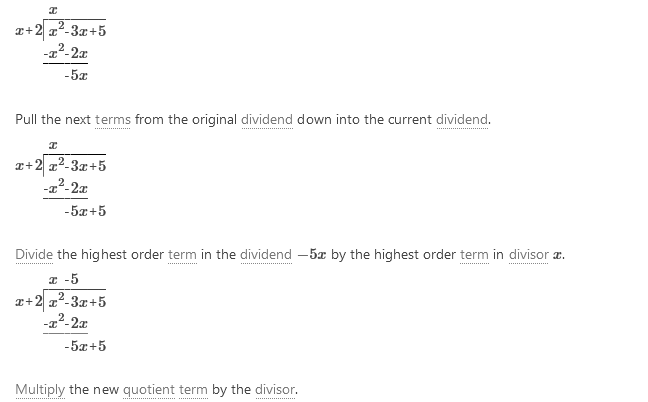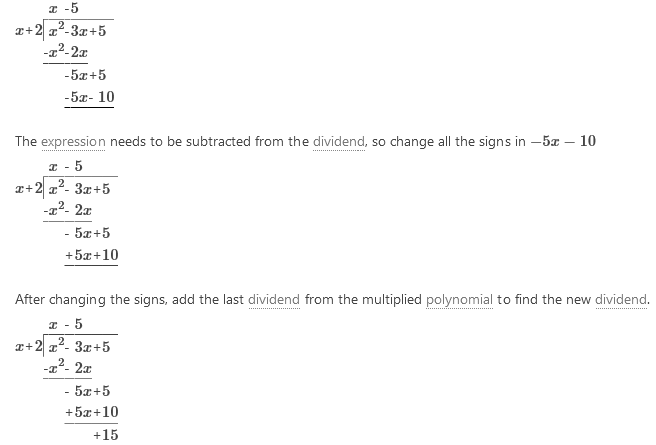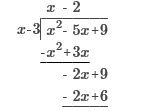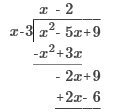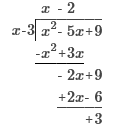|
Accounting | Business | Computer Science | General Studies | Math | Sciences | Civics Exam | Help/Support | Join/Cancel | Contact Us | Login/Log Out Intermediate
Algebra Chapter 1 2 3 4 5 6 7 8 9 10 11
Elementary and Intermediate Algebra Chapter 4: Exponents and Polynomials
These Study Guides Are 100% Free
 Donate Please (Help keep it free)! This course is 100% Free. If you need more help with your class, I suggest Joining Now! Use the rule of exponents to solve -5x3
⋅ 7x5
-358 -5 ⋅ 7 = -35
Use the rule of exponents to solve 3x3y
⋅ (2xy4)2
12x5y9 Use the rule of exponents to solve -4a6b5 ÷ (2a5b) -2ab4  Use the rule of exponents to solve 3x-2 ⋅ 5x7 15x5 3x ⋅ 5x = 15x -2 – 7 = 5 Use the rule of exponents to solve  -2a5 = -32a5 b2 + 5 = b10 Use the rule of exponents to solve
Use the rule of exponents to solve
We use the negative exponent rule. Use the rule of exponents to solve (-2x-6y)3   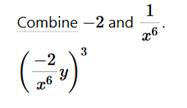  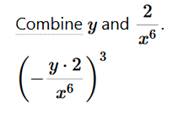 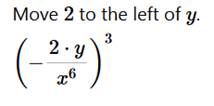      Convert 5,433,000 to scientific notation: 5.433 ⋅ 106 First, we will put a decimal point at the end of number 5433000. To write number 5433000. in scientific notation we need to move the decimal point from its current location (black dot) to the new position (red dot). 5.433000. So, we need to move decimal point 6 places to the right. This means that the power of 10 will be positive 6. Now we have that the Number part = 5.433000 (which can be written as 5.433) and Exponent part = 6 5.433 ⋅ 106
6.5 ⋅ 10-6 To write number 0.0000065 in scientific notation we need to move the decimal point from its current location (black dot) to the new position (red dot). 0.000006.5 So, we need to move the decimal point 6 places to the left. This means that the power of 10 will be negative 6. Now we know that the base = 6.5 and Exponent = -6 So, the solution is: 6.5 ⋅ 10-6 3,200 103 = 1,000 3.2 ⋅ 1,000 = 3,200 0.00008 10-5 = 0.00001 ⋅ 8 = 0.00008 Convert 3.5 billion to standard notation. 3,500,000,000 Convert 12 trillion to standard notation. 12,000,000,000,000 Perform the computation by converting (80,000) (0.000006) to scientific notation. 4.8 ⋅ 10-1 (80,000) (0.000006) = 0.48 0.48 = 4.8 ⋅ 10-1 7x3 + 4x2 + 2x – 11 We need to combine like terms. If some have no like term, then that will stand alone. We move from left to right. Like Term or terms means base numbers, which have the same variable and exponent. (Example: 7x3 7 is the base number, x is the variable, and 3 is the exponent.) (7x3 – x2 – 6) + (5x2 + 2x – 5) 7x3 stands alone. -x2 + 5x2 = -1x2 + 5x2 = 4x2 (notice that that variable and exponent remains the same, and only the base changes) 2x stands alone. -6 + -5 = -11 Now we put the equation back in proper order of operation. 7x3 + 4x2 + 2x – 11 Perform the operation: (x2 – 3x –
6) - (2x2 + 6x – 7)
-x2 – 9x + 1 This will be the same, except we subtract. Remember, we group in like terms, and change only the base numbers unless there is no like term. x2 – 3x – 6 (the 7 becomes positive in this case because we are multiplying 2 negatives) -x2 - 9x + 1 Note: whenever a negative is before an equation inside paratheses, we must multiply each Expression by -1.  -2y2 + 3y It may be easier to rewrite this operation like so. (6y3 – 9y2) ÷ -3y We do this to remind us that we need to divide the ENTIRE numerator (top) by the denominator (bottom). So, in this case, we need to divide both expressions above the line by the expression below the line. If there were two expressions below the line, we would not, for various reasons, but we will not get into that now. So, this is rather simple now that we have rewritten the operation. (6y3 – 9y2) ÷ -3y We divide 6y3 by -3y (it will become negative, and we need to subtract 1 from the exponent because -3y is -3y1). 6y3 ÷ -3y = 6 ÷ -2 = -2, and the exponent 3 – 1 = 2 = Next, – 9y2 ÷ -3y = Now we put the equation back together. -2y2 + 3y -1 This is exactly what I was talking about above. This could be written like the operation above. Since there are 2 expressions as the denominator, we need to divide like terms. The variables will be subtracted and cancelled, because in essence, they have exponents with the same value. x1 - x1 = 0 -2 ÷ 2 = -1 The answer is -1
15x5 – 21x4 + 12x3 – 3x2 3 ⋅ 5x2 x3 + 3 ⋅ −7x2x2 + 3 ⋅ 4x2x − 3x2 = 15x5 – 21x4 + 12x3 – 3x2 x2 + 3x – 10 x ⋅ x + x ⋅ −2 + 5x + 5 ⋅ −2 = x2 + 3x – 10
Find the product of (3a - 7) (2a + 5)
6a2 + a – 35 3a (2a) + 3a ⋅ 5 − 7(2a) – 7 ⋅ 5 = 6a2 + a – 35 Find the product of (a - 7)2 a2 – 14a + 49 (a – 7) (a – 7) a ⋅ a + a ⋅ −7 – 7a −7 ⋅ −7 a2 – 14a + 49 Find the product of (4x + 3y)2 16x2 + 24xy + 9y2 Rewrite: (4x+3y) (4x+3y) 4x(4x) + 4x(3y) + 3y(4x) + 3y(3y) = 16x2 + 24xy + 9y2 Find the product of (b – 3) (b + 3) b2 – 9 b ⋅ b + b ⋅ 3 – 3b – 3 ⋅ 3 = b2 – 9 9t4 – 49 3t2 ⋅ 3t2 + 3t2 ⋅ 7 – 7 ⋅ 3t2 – 7 ⋅ 7 Find the product of (4x2 - 3) (x2 + 2) 4x4 + 5x2 - 6 4x2x2 + 4x2 ⋅ 2 – 3x2 – 3 ⋅ 2 = 4x4 + 5x2 - 6
Find the product of (x - 2) (x + 3) (x - 4)
x3 – 3x2 – 10x + 24 x ⋅ x + x ⋅ 3 − 2x −2 ⋅ 3 ⋅ (x−4) = (x2 + x − 6) (x − 4) x2x + x2 ⋅ −4 + x ⋅ x + x ⋅ −4 – 6x – 6 ⋅ −4 x3 – 3x2 – 10x + 24
2 +
x – 5 +
14
(3)3 – 5(3) + 2
27 – 15 + 2 12 + 2 = 14 2, -4
P (0) x2 – 5x + 2 = (0)2 – 5(0) + 2 = 0 – 0 + 2 = 2 P (3) = (3)2 – 5(3) + 2 = 9 – 15 + 2 = -4
x – 2, 3
-2x2 + x + 15 x2 – 3x2 = -2x2 -3x + -(-4) = -3x + 4x = x 6 + -(-9) = 6 + 9 = 15 Put the equation back together. -2x2 + x + 15
a.
Find polynomials A(x) and P(x) that
represent the area of the pool table.
b. Find A(4) and P(4). a. A(x) = x2 + 4x b. P(x) = 4x + 8 a. A(4) = 32 ft2 b. P(4) = 24 ft A(4) = (4)2 + 4(4) = 16 + 16 = 32 P(4) = 4(4) + 8 = 16 + 8 = 24 Find a polynomial R(q) that represents the revenue if the price is $8 for each football. R(q) = -150q2 + 3000q $14,400 -150(8)2 + 3000(8) -9,600 + 24,000 = 14,400 |
| Home |
Accounting & Finance | Business |
Computer Science | General Studies | Math | Sciences |
Civics Exam |
Everything
Else |
Help & Support |
Join/Cancel |
Contact Us |
Login / Log Out |
